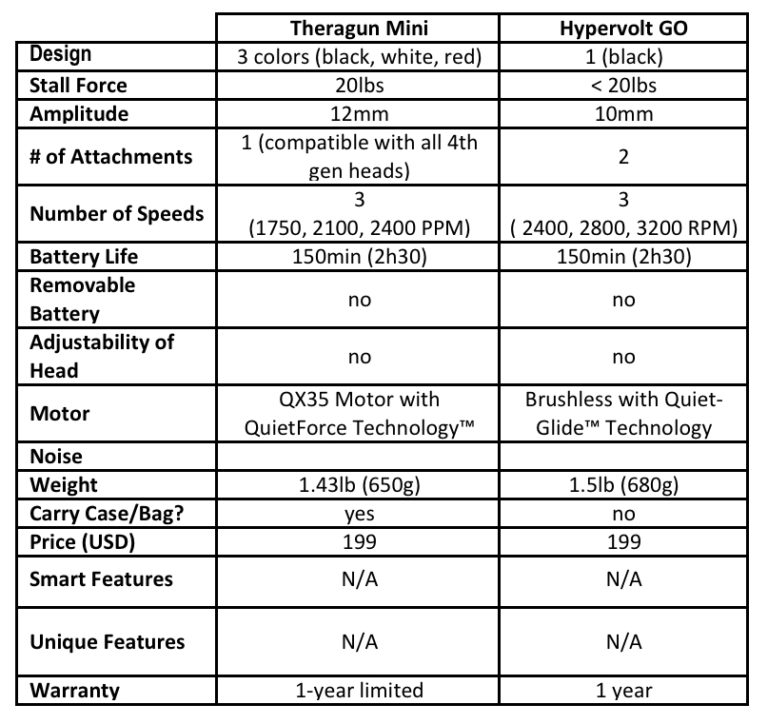Being a direct competitor to Therabody, it is no surprise that Hyperice released the Hypervolt GO to compete directly with the Theragun MINI. But does it, really? This is what we are going to find out. The specifications for both are as follow:

AMPLITUDE
There is a 2-milimeter difference between the amplitude of both massagers. Indeed, with 12 mm, the Theragun MINI takes the leads over the Hypervolt GO, making it reach slightly deeper.

STALL FORCE
As far as the stall force is concerned, 20lbs is not enough to get a deep massage, which is where the Theragun Mini falls. The Hypervolt GO fails lamentably in this category, with a stall force less than 20lbs. One might argue that with the bullet head, it would take more force to stall the motor on the GO, but that is not true and here’s why. The smaller the surface of the head, and the more painful it is going to feel. The more painful, the less likely you would be to apply more pressure to stall the motor. It does not change the fact that the stall force is still less than 20lbs, making this Hypervolt GO a weak massage gun.
BATTERY
Both the Theragun MINI and Hypervolt GO have an internal battery that lasts 150 minutes (2.5 hours) per charge. The internal battery means that when it is damaged both massagers will be done for and will need to be replaced entirely.
NOISE
Being different type of massage guns, the Hypervolt GO and Theragun MINI are built with different motors. So, obviously, they are going to sound differently. I tested them both with a mobile noise tester app, the maximum noise levels recorded were as follows:
- For the Hypervolt GO: 64.8dB at speed 1 (2400 RPM’s), 70.3dB at speed 2 (2800 RPM’s), and 74.5 dB at speed 3 (3200 RPM’s). Those noise levels are not “super quiet” at all.
- For the Theragun MINI: 71.1dB at speed 1 (17500 PPM’s), 74.3dB at speed 2 (2100 PPM’s), and 78.7 dB at speed 3 (2400 PPM’s).
As you can see the Hypervolt GO is slightly quieter than the Theragun MINI, but still loud. They both are.
PORTABILITY
The Theragun MINI is very easy to take with you anywhere because of how small and compact it is. Plus, everything that it comes with (charger and ball head attachment) can be squeezed in the pouch with the massager.
The Hypervolt GO on the other hand does not even come with a carry case or a pouch. As a matter of fact, there is none that exists for this massager yet. The Hypervolt GO is also slightly bigger than the Theragun MINI, and too big for a mini massage gun. But you can throw it in your backpack and take it with you where you go. It is just a miss not to have a case to keep it and its elements safe and together in one place.
The difference in the weight here is not too much either. The Theragun MINI weighs 1.43lb (650g) while the Hypervolt GO weighs 1.5lb (680g), making the Hypervolt GO slightly heavier than the Theragun MINI.
UNIQUE FEATURES
Neither massager has any unique features or Bluetooth® connectivity. However, both can be used to follow routines within the Therabody and Hyperice apps.
PRICE
Both the Theragun MINI and Hypervolt GO cost $199USD, which actually makes the Hypervolt GO more expensive than it is worth. And that is my opinion.
You can buy the Theragun Mini here and the Hypervolt Go here. Please, note that these are affiliate links and your purchase through them might earn me some commissions.
THOUGHTS
Neither of these massagers should be own on their own as they won’t deliver you the quality of massage that their full-size brethren would. However, mini massage guns make for good companions on-the-go. Hyperice just sacrificed a bit too much with the Hypervolt GO here. 30% smaller than the full-size Hypervolt’s, no carry case, loud, weak. I truly wanted to love this massage gun, but I can’t. I would not recommend the Hypervolt GO, but at the end of the day, you do what you please with your money.

